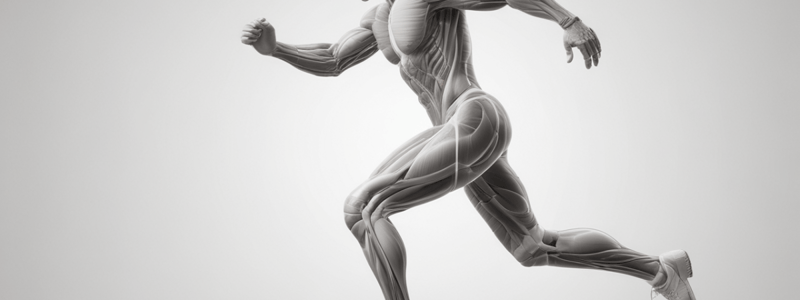Podcast
Questions and Answers
What is a common cause of hip flexor strain?
What is a common cause of hip flexor strain?
Sudden contraction or overstretching of the hip flexor muscles
What is a symptom of hip flexor strain that may be noticed when walking or running?
What is a symptom of hip flexor strain that may be noticed when walking or running?
Pain or stiffness in the front of the hip or groin area
What is a treatment option for hip flexor strain?
What is a treatment option for hip flexor strain?
Stretching and foam rolling to improve flexibility and reduce muscle tension
What is the goal of Phase 1 in the rehabilitation of hip flexor strain?
What is the goal of Phase 1 in the rehabilitation of hip flexor strain?
What is a way to prevent hip flexor strain?
What is a way to prevent hip flexor strain?
What is a common symptom of hip flexor strain that may be noticed when bending the hip?
What is a common symptom of hip flexor strain that may be noticed when bending the hip?
What is a treatment option for hip flexor strain that can address biomechanical issues?
What is a treatment option for hip flexor strain that can address biomechanical issues?
What is a way to prevent hip flexor strain that targets the core and gluteal muscles?
What is a way to prevent hip flexor strain that targets the core and gluteal muscles?
Flashcards are hidden until you start studying
Study Notes
Hip Flexor Strain
Causes
- Sudden contraction or overstretching of the hip flexor muscles (iliacus, psoas major, and tensor fasciae latae)
- Muscle imbalance or weakness in the hip flexor muscles
- Poor biomechanics or running technique
- Overtraining or repetitive strain
- Direct blow or trauma to the hip or groin area
- Muscle fatigue or poor warm-up/cool-down routines
Symptoms
- Pain or tenderness in the front of the hip or groin area
- Pain when lifting the knee towards the chest or bending the hip
- Pain when walking, running, or climbing stairs
- Stiffness or limited range of motion in the hip joint
- Bruising or swelling in the affected area
- Weakness or fatigue in the hip flexor muscles
Treatment Options
- Rest and ice to reduce inflammation and pain
- Compression and elevation to reduce swelling
- Stretching and foam rolling to improve flexibility and reduce muscle tension
- Strengthening exercises to target the hip flexor muscles
- Pain relief medication or anti-inflammatory injections
- Physical therapy to address biomechanical issues and improve running technique
Rehabilitation
- Phase 1 (0-2 weeks): Rest, ice, compression, and elevation (RICE) protocol
- Phase 2 (2-4 weeks): Gradual return to activity with stretching and strengthening exercises
- Phase 3 (4-6 weeks): Progressive strengthening and functional exercises
- Phase 4 (6+ weeks): Return to full activity with continued maintenance exercises
Prevention
- Warm-up and cool-down exercises to reduce muscle strain
- Stretching and foam rolling to improve flexibility and reduce muscle tension
- Strengthening exercises to target the hip flexor muscles
- Proper running technique and biomechanics
- Gradual progression of training intensity and volume
- Incorporating strengthening exercises for the core and gluteal muscles to reduce hip flexor strain
Hip Flexor Strain
Causes
- Sudden contraction or overstretching of hip flexor muscles (iliacus, psoas major, and tensor fasciae latae) causes strain
- Muscle imbalance or weakness in hip flexor muscles leads to strain
- Poor biomechanics or running technique contributes to strain
- Overtraining or repetitive strain causes strain
- Direct blow or trauma to the hip or groin area causes strain
- Muscle fatigue or poor warm-up/cool-down routines contribute to strain
Symptoms
- Pain or tenderness in the front of the hip or groin area is a symptom
- Pain when lifting the knee towards the chest or bending the hip is a symptom
- Pain when walking, running, or climbing stairs is a symptom
- Stiffness or limited range of motion in the hip joint is a symptom
- Bruising or swelling in the affected area is a symptom
- Weakness or fatigue in the hip flexor muscles is a symptom
Treatment Options
- Rest and ice reduce inflammation and pain
- Compression and elevation reduce swelling
- Stretching and foam rolling improve flexibility and reduce muscle tension
- Strengthening exercises target hip flexor muscles
- Pain relief medication or anti-inflammatory injections relieve pain
- Physical therapy addresses biomechanical issues and improves running technique
Rehabilitation
- Phase 1 (0-2 weeks): RICE protocol (rest, ice, compression, and elevation)
- Phase 2 (2-4 weeks): Gradual return to activity with stretching and strengthening exercises
- Phase 3 (4-6 weeks): Progressive strengthening and functional exercises
- Phase 4 (6+ weeks): Return to full activity with continued maintenance exercises
Prevention
- Warm-up and cool-down exercises reduce muscle strain
- Stretching and foam rolling improve flexibility and reduce muscle tension
- Strengthening exercises target hip flexor muscles
- Proper running technique and biomechanics prevent strain
- Gradual progression of training intensity and volume prevents strain
- Strengthening exercises for core and gluteal muscles reduce hip flexor strain
Studying That Suits You
Use AI to generate personalized quizzes and flashcards to suit your learning preferences.



